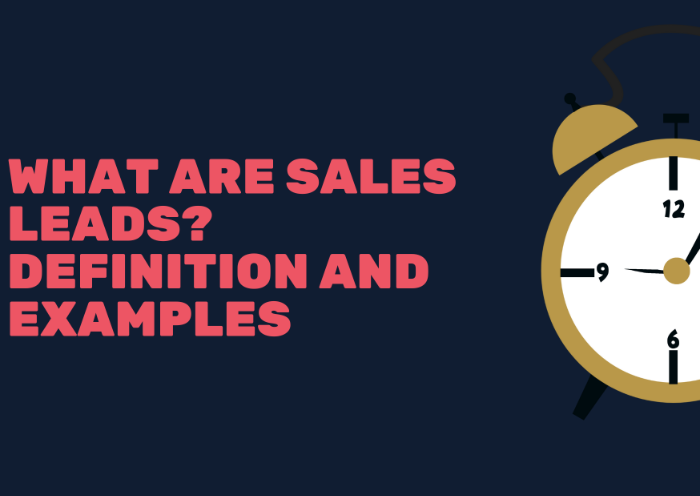
Businesses work to earn a profit, and companies that cannot earn an adequate amount of revenue shut down. Earning profits requires companies to sell products, there are different strategies companies use to gain clients. The process starts with companies advertising the product or service. Companies utilize several advertisement methods to create brand awareness. People learn about the company’s commodities. Companies then prepare customer profiles that have the characteristics of an ideal customer. Sales leads are identified and companies approach them. Companies educated prospects to sell products or services. The education or persuasion process requires efforts from sellers to convert the prospect.
Sales leads are an important part of the selling process, they are converted into clients for selling products. It's a long process that could take weeks to complete and close the deal. Organizations start with marketing and then the responsibility is transferred to sellers. Sellers interact with leads to learn about their requirements and provide solutions. Companies utilize emails, phone calls, or direct meetings for interacting with clients. So, the process starts with leads and winds up with organizations selling them their products or services. Leads are an important part of trade therefore companies must learn about it. This article would provide all essential details regarding leads and would help small businesses upgrade their selling process for revenue growth.
Sales Leads
People or businesses identified by companies as potential clients are called sales leads. Leads are people who have the potential to be customers. Companies create customers profile that has all characteristics of ideal customers. Consumers that fit the profile are identified as leads. The leads could be people who have shown interest in a product or service, although they don’t possess the characteristic of an ideal customer. Customers could show interest by contacting organizations through social media or any other source or clicking the links and providing personal information. Lead are worked upon to convert into a client, most leads leave between identifying the flaws in the system.
Companies could also purchase leads from third parties; however such leads have a low conversion rate and are considered less viable. Companies use social media or direct marketing to aware people of their products. Prospects then show interest in the product by providing personal information through landing pages. Information is utilized by companies to contact them. Marketing departments make initial contact to learn more about the prospects. Prospects are further transferred to the sales department for further persuasion. Sellers interact with leads to educate them about products or services. They provide necessary information regarding their company and the items being sold. Through persuasion, leads are converted into customers.
Sales leads can either be a single individual or another business. Converting individual clients is easy as they aren’t much aware of the market and require surface information. However business-to-business clients require much more than that. They are decision-makers who run a business, there can be more than one person that needs information to finalize decisions. Sellers have to put more effort into persuading business clients than normal clients. Strategies to capture leads, persuasion techniques, and contacting sources are all different in these cases.
Sales Leads Types
Leads can be divided into three different types; the division is based upon the level of information they have about the company and product and the interest level they have in the said product. Based upon the type of lead companies devise their approach. Information conveyed to the lead by the sales department also varies based on their types. Following are the three types of leads:
1. Cold Leads
2. Warm Leads
3. Hot Leads
Cold Lead
Cold leads are the least knowledgeable about the organization and its product or service. Such people have very little to no knowledge about the company’s product but have the potential to become clients. Organizations use introductory content to approach clients. Such clients have little knowledge so providing detailed information could overwhelm them. Sales departments must take a slow approach toward the leads. Use emails or social media contacts to interact with such consumers. Cold calls are not considered viable options in this case. Create catch subject lines and concise emails to gain the attention of the clients and wait for them to show interest.
Leads purchased through third-party services can be categorized as cold leads. They haven’t heard of the organization but the organization gains their information based upon their characteristics. Such clients are approached through emails or other social media websites. Personalized emails can grab clients’ attention. Sales departments must approach with concise information and try to gain more client information. Provide them offers if they show some interest to gain more trust and create a relationship. Cold leads might have less information about the company’s product or service but companies must not compromise on their importance. Every consumer has the potential to become a client.
Warm Leads
People who have firsthand information about the product and have shown interest in the company or its product through marketing channels. Consumers are approached through ads and emails; companies add links to their landing pages. Landing pages offer lead magnets to gain consumers’ personal information. Consumers that fill out the form in exchange for the offer or just click the link and considered a warm lead. They haven’t committed to purchasing the product, but little effort by the sales department could convert such leads. Warm leads might have shown interest but they aren’t ready to purchase, some people like the company’s mission and show interest, however, such people aren’t clients.
Sales departments need to put in little effort compared to cold leads to convert them. Learn about consumers' requirements, try to understand the problem, and provide solutions. Provide information regarding the product, and how it could be a solution. Warn leads to require more information and need solid reasons to be persuaded. Warm leads are people or companies who contacted the company in past or those who have been referred by an old customer. They have firsthand information and show interest in themselves. Companies often look for warm sales leads because the conversion rate is high and the return-on-investment increases.
Hot Leads
Hot leads are what any business wants, such people are interested in a product and ready to purchase the item or service. Such businesses or people know all about the product, they know prices, quality of the product, shipping fees, and packaging. The only thing remaining is the sales department closing the deal. Cold or warm leads are eventually turned into hot leads by sellers. There is always little to no chance that hot leads don’t convert. No effort is required at the sellers' half, they just have to provide the product and receive money to close the deal.
Hot leads mostly connect themselves with companies, marketing departments have a little role in this but mostly they are referrals or people who have done their independent research. Businesses or individuals do research on their own to find the best product in the market, and such people finally contact a business to purchase. Referrals are well informed by friends who are already a customer of the company and require little to no effort for conversion. The cost of conversion for hot leads is low, therefore return on investment is typically high.
Where to Find Sales Leads?
There are several sources to find leads, leads require information and companies need a medium of communication to initially provide the message. Marketers send messages in form of advertisements. Ads are placed on different platforms that attract audiences to the company. Creating leads is quite simple however if one master’s the art. Following are the sources that provide leads for companies:
Referrals
Customer referrals are generated by providing offers to current consumers to bring new customers. Incentives are provided to the customers in exchange for the number of consumers they bring. Sales lead generated through the method have high conversion rates. Such sales leads are easy to convert and require less effort by sellers to convince them. Old eutomers often refer people out of loyalty to the brand. Companies must create strong relations with customers to gain their trust. Costs for referral programs are low because customers could refer new clients at small discounts. Return on investment however is high.
Studies suggest that more than 50% of sales leads are generated through referring systems. Referring is a type of outsourcing where the customer works for the company in exchange for small rewards.
Social Media
Social media has become very important in the current scenario. During COVID the lack of social interaction created a space that was filled by social media. Companies shifted their marketing to social media and most sales campaigns have also transferred online. Companies run ads on social media sites to capture the audience’s attention. On the page, forms are used to gain clients' information, and leads are generated. Social media pages allow targeted marketing, organization could choose the people and area they want to target. Age, sex, status, and likeness of audiences could be filtered to advertise products. Facebook is a highly recommended platform for B2C leads and LinkedIn is utilized for B2B clients.
Facebook has around 2 billion users daily, 2 billion is a huge number, and companies could target these people. Facebook advertisement is cheap and has features that aren’t offered anywhere else. LinkedIn is a social media website that allows interaction with business clients. Sales departments could filter decision makers by their position to reach out. Social media has a high potential for generating leads. CRM integration could help improve the quantity and quality of leads generated.

Don't know how to increase sales?
No problem, just know people.
Company Website
A company’s website is highly compatible for generating leads, people often search for solutions online. A company that has a highly optimized website. Search engine optimization appears high on search engines and consumers have a high chance of visiting the website. The website’s design also plays a role in capturing sales leads. The website should have information on the right pages, all information at once could overwhelm the customer. Leads through the website are inbound leads and have high conversion chances. Most leads from websites are hot leads that are ready to be converted.
Websites optimized for mobile devices have high lead generation ability. Most clients are often working from mobile phones. Website optimized for mobile experience could grab more sales leads.
Third Parties
Companies could also purchase leads from third-party sellers. These companies are well experienced in lead generation and sell information to other businesses. Such leads are mostly categorized as cold leads but little effort could turn them into customers. Purchasing sales leads could provide companies a head start, sellers have people they need to work on, to create a buzz. Contact information of leads is available which is utilized for interaction. Companies looking to learn about their requirement and provide solutions to their problems. Companies could purchase leads in bulk but the conversion rate is low. Sellers have to put effort to convert leads.
Conclusion
Sales leads are potential customers of companies that have a chance to become clients. Companies work hard to gather leads and convert them into clients. Most leads require many efforts by sellers to convert, some leads called hot leads are ready to purchase. In this article, you could learn about leads and the sources that could help generate leads.



































































